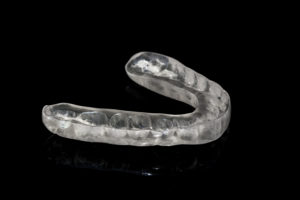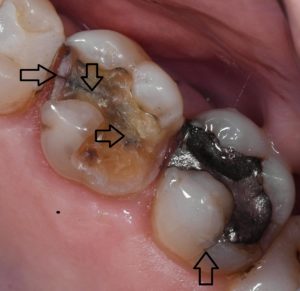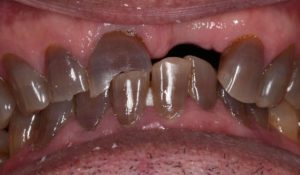
A certain degree of “wear and tear” of our teeth and gums is a natural part of aging. We may notice receding gums, wearing down of some teeth, or that our teeth are cracking or breaking more often than they used to. While many of these age-related changes are to be expected, there is actually a lot we can do to prevent or slow them down.
We are living longer, and if we are to maintain our teeth and the ability to eat comfortably during the course of our longer lives, we must take care of our dentition from an early age. As you will read below, excessive tooth wear doesn’t only affect older individuals. Permanent damage to the teeth from wear can start at an early age.
Tooth wear
There are 3 main types of tooth wear – attrition, abrasion and erosion – each defined by the cause of wear. Often when we see tooth wear it is from a combination of these 3 factors.
Attrition
Attrition is wear resulting from tooth-on-tooth contact. It is common in people who clench or grind their teeth, especially when this happens during sleep when there is no conscious control. Often the person who grinds their teeth has no idea they are doing it.
To protect the teeth from the wear, cracks, and fractures that are caused from clenching or grinding, your dentist may recommend a special mouthguard-type device called an occlusal splint. An occlusal splint usually fits over the top teeth but also protects the lower teeth by stopping the upper and lower teeth from interlocking.
 Abrasion
Abrasion
Abrasion is tooth wear resulting from contact of a non-tooth object with the teeth, such as a toothbrush, coarse foods, or occupational exposure to dust and grit.
It is common to see wedge-shaped divots on the outside surface of teeth just above the gum. This is accompanied by receding gums which expose the root surface of the tooth, which is relatively soft and weak and vulnerable to wear. To help prevent receding gums and abrasion always use soft toothbrush. Medium and especially hard toothbrushes can be damaging.
As abrasion progresses, the tooth structure overlying the nerves and blood vessels inside the tooth becomes thinner, risking exposure of the nerves. This may be associated with sensitivity, but not always. Your dentist may recommend sealing over this part of the tooth with tooth-coloured resin, to protect the area from further wear.
 Erosion
Erosion
Erosion is tooth wear resulting from contact with chemicals which dissolve tooth structure, usually acid contained in foods and drinks. It can also be caused by regurgitation of acidic stomach contents, such as with gastro oesophageal reflux disease (GORD) or certain eating disorders. Acid erosion is a common cause of tooth sensitivity.
Alarmingly, we are currently facing an “epidemic” of excessive tooth wear caused by regular intake of acidic drinks such as soft drink, energy drinks, and sports drinks which actually erode the tooth surface away! Dentists are seeing a disturbing amount of young people with levels of tooth wear quite advanced for their age. Other acidic foods and drinks include many fresh fruits, salad dressings, wine, and coffee.
All this doesn’t mean we have to avoid the foods and drinks we love, and certainly many acidic foods and drinks form part of a balanced diet. However there are ways that we can limit the damage. Your dentist can offer guidance here, and may provide products which help replenish lost minerals back into the teeth while also preventing further wear.
Restoring worn teeth
When wear is more advanced or preventative measures have failed, treatment may be required to help restore chewing function and appearance, and protect the teeth from further wear.
There are several treatment options available to help restore chewing function and the appearance of worn teeth including bonding, veneers, and crowns. These treatments may also help prevent further wear by covering and protecting the teeth. Your dentist will discuss the appropriate options with you.
Protecting teeth from excessive wear is important. If tooth wear is allowed to progress without intervention, the nerves and blood vessels (called pulp tissue) inside the teeth can start to die. This can occur slowly without any pain or sign of a problem. Eventually a tooth infection develops from this “dead tooth” which must be treated with root canal therapy or extraction.

Cracked or broken teeth
Cracked or broken teeth are becoming more common because people are keeping their teeth longer than in previous generations. These teeth may have become more weak over the years, having had decay, repeated fillings, and sustaining the forces of daily chewing.
It is very common to have cracks running through teeth, especially when the teeth have suffered trauma, have large fillings, or have been subject to excessive clenching or grinding for example during sleep.
Usually the patient is unaware of cracks in their teeth, having no associated pain. When there are symptoms, they can include sharp pain when biting certain foods, sensitivity to cold or hot or sweet and difficulty pinpointing whether the pain is coming from a top or bottom tooth.
Preventing cracks and their progression will preserve the teeth long-term and save the need for more complex dental treatment in the future.
Prevention includes:
Avoiding chewing on hard things like ice or boiled lollies
Wearing a mouthguard during at-risk activities
Provision of an occlusal splint (see section on Attrition above)
Your dentist may recommend certain treatments which can help stop or slow down crack progression. These may include:
- Reducing the tooth out of the bite by filing it down
- Removing weakened portions of tooth and placing a large filling
- Placing a temporary metal band around the tooth
- Placing a crown over the tooth
As a crack progresses through the tooth, parts of the tooth may break off. Sometimes the tooth breaks in such a way that it can no longer be filled or restored. Cracks may also progress deep inside the tooth toward the pulp i.e. the nerves and blood vessels in the tooth’s centre. In this instance the pulp may die and infection in the tooth may develop. It will then be necessary to perform root canal therapy or extraction. In severe cases, the cracked tooth can split in half in which case it will need to be extracted.

